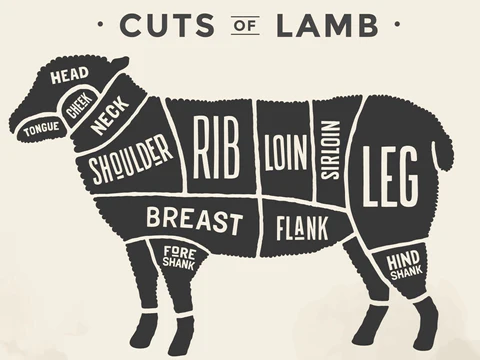Lamb Steak Recipes
For centuries, lamb has been an integral part of the Scottish diet, woven into the very fabric of the nation's history and culture. From slow-cooked hearty stews in the Highlands to sizzling lamb steaks with crispy potatoes in the Borders, lamb's versatility is celebrated in a myriad of different recipes throughout Scotland and worldwide.
Whether you are looking for a recipe with classic European flavours such as traditional Greek lamb steaks marinated in olive oil, lemon, oregano and garlic and served with tzatziki and pita bread, or you are after some Middle Eastern influence such as Shawarma-spiced lamb steaks marinated in a mix of cumin, coriander, paprika, and garlic, we have got you covered!
The Scotch Difference
The secret behind Scotland's reputation for outstanding lamb lies not only in its rich culinary heritage but is deeply rooted in the land itself and the time-honoured, sustainable rearing traditions practiced by its farmers ensuring that the lamb is always of the highest quality. It is this unparalleled combination of nature's bounty and the dedication of generations of farmers that makes Scotch lamb not just a meal, but a culinary experience.
Which Part of the Lamb?
Lamb steaks are typically cut from the larger muscles of the animal, especially the hindquarters and the loin. Here's a quick breakdown:
✅ Lamb Loin Steak:
- This is arguably the most tender steak you can get from a lamb.
- It is cut from the waist of the lamb, and when it's boneless, it looks somewhat similar to a small beef T-bone steak.
- The loin steak combines two muscles separated by a bone: on one side you have the tenderloin, and on the other, you have the larger loin muscle.
✅ Lamb Leg Steak:
- These are slices from the leg of the lamb, which is a lean and flavourful muscle.
- Lamb leg steaks may be boneless or may contain a portion of the leg bone.
- Because the leg does more work than other parts of the lamb, leg steaks can be a bit tougher than loin steaks. However, when cooked correctly, they become tender and flavourful.
✅ Lamb Shoulder Steak:
- The shoulder is a more exercised part of the lamb, which means that it can be tougher but contains a lot of flavour.
- Shoulder steaks are often braised or slow-cooked to tenderise them.
✅ Rump & Chump Steaks:
- Cut from the top part of the leg, rump steaks are lean, tasty, and great for grilling.
- Chump steaks are meaty and also cut from the leg, just above the joint that connects to the loin.

How to Prepare the Perfect Lamb Steak?
When setting out to cook the perfect lamb steak, your journey starts with selecting the right cut.
- Age Matters: Look for young lamb, often called 'spring lamb', which is tender and has a mild flavour.
- Appearance: The meat should be a bright, fresh red colour with white marbling. The fat should be creamy white, and there shouldn't be excessive moisture in the packaging.
- Cut Preference: Loin and rump steaks are among the most tender cuts and are perfect for quick cooking methods like grilling or pan-searing. Lamb leg steaks, being lean yet flavourful, are also suitable for these cooking methods but can handle longer cooking if preferred.
- Bone-in vs. Boneless: While boneless steaks might offer more uniformity in cooking, bone-in steaks can provide additional flavour and are often juicier.
- Marinating: Depending on your recipe, consider marinating the lamb steak for at least 2 hours, or even overnight for deeper flavour infusion. Classic marinade ingredients include garlic, a little salt, rosemary, olive oil, lemon juice or balsamic vinegar. However, lamb's versatility allows for an array of other flavours from mint to spicy harissa.
- Temperature Matters: Always bring your lamb steak to room temperature before cooking. This ensures even cooking and helps achieve that desired tenderness. Remove it from the refrigerator about 20-30 minutes prior to cooking.
- Drying: Pat the steak dry with paper towels. This helps achieve a good sear and prevents steaming when cooking.
- Pan-searing: Bring a heavy-based skillet to high heat. Once it's hot, add oil and place your lamb steak in. For a medium-rare finish, cook for about 3-4 minutes on each side, depending on the thickness. Adjust timing for desired doneness.
- Oven-roasting: Once you sear your steaks in a hot pan, you can transfer them to a preheated oven (around 400°F or 200°C) for 5-10 minutes.
- Resting: This step is vital. Once cooked, let the lamb steak rest for at least 5 minutes, allowing juices to redistribute. This ensures a juicier steak.
- Temperature Checks: For a perfect recipe, precision is key - use a meat thermometer. For medium-rare lamb, aim for an internal temperature of about 130°F to 135°F (54°C to 57°C).
Where Can I Find Scotch Lamb Near Me?
If you are looking for quality, locally sourced Scotch Lamb, look no further than our user-friendly interactive map. Simply enter your location and the map will pinpoint your nearest Scotch meat butcher or supplier, and you will be cooking up a storm in no time!
Supporting Scottish Farmers
By choosing Scotch Lamb, you are also supporting our dedicated Scottish farmers who have been carrying out time-honoured farming traditions for generations ensuring that only the best meat graces our tables.
Click on the map today and cook something truly special with Scotch Lamb today!
What's The Scotch Difference?
Let us take you on a journey into what makes Scotch Beef, Scotch Lamb and Specially Selected Pork so special, and how we produce such high-quality meat renowned and enjoyed worldwide.


- © MakeitScotch 2026
- Cookies
- Privacy
- Terms of Use
Site by Art Department
